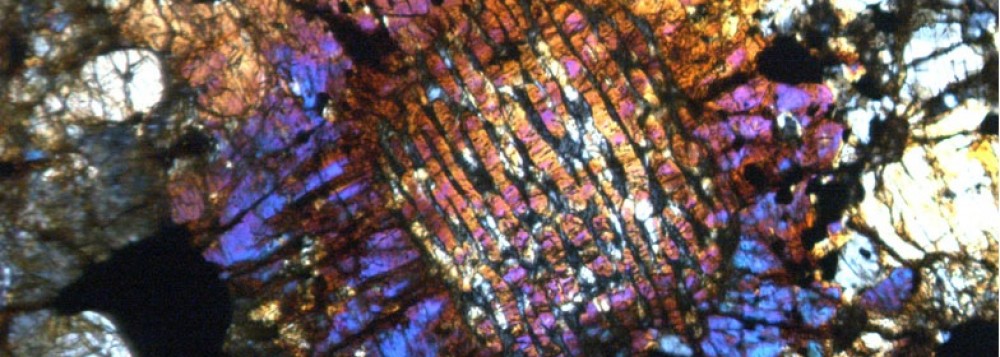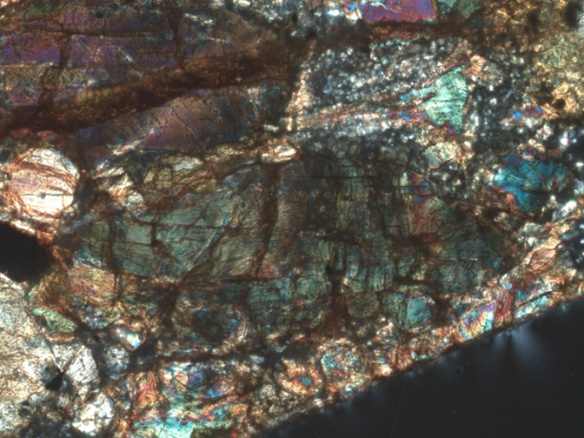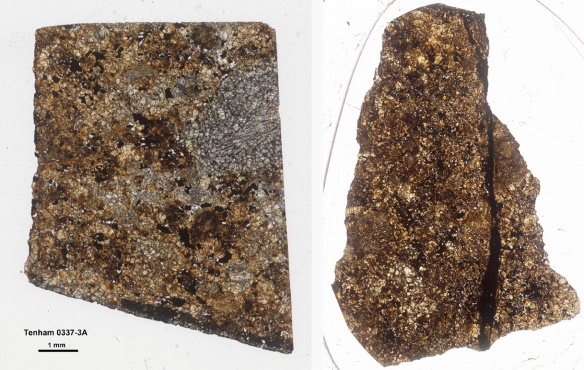There was a discussion about shock classification and a type 3.00 chondrite on the meteorite list recently. It was assumed by some that a type 3.00 chondrite could not have experienced shock. I went back to Stoffler, Keil and Scott 1991 to look at the pressures and temperatures for the different shock stages. Turns out there is very little heating (approx. 10-20 degrees C) for low shock stages (such as S2), certainly not enough to “metamorphose” a chondrite. But re-reading this paper got me thinking about how one determines the shock stage of an ordinary chondrite.
Stoffler, et al. 1991 is the paper that explains how to determine shock stage in an ordinary chondrite. Classification information is summarized in Table 1 of their paper. A slightly different version of their table is found in a nice article on shock effects in ordinary chondrites published by PSRD (http://www.psrd.hawaii.edu/April04/asteroidHeating.html ). Shock stages are based primarily on deformation of olivine grains. The PSRD article has some good illustrations of “shocked” olivine grains.
If one actually reads through Stoffler, et al. 1991, one sees that shock stage should be determined by examining “ten to twenty of the largest, randomly distributed olivine single crystals with high interference colors, at least 50-100 microns in size “, viewed in cross-polarized light, and preferably a 20x objective. Also, Stoffler, et al. 1991 “recommend to choose the highest shock stage shown by any significant fraction of grains (at least 25%) to establish the shock level of a chondrite.” They also note that “When we assign a shock stage to such a breccia, it is our estimate of the equilibration peak shock pressure experienced by the whole rock.”
This is a very specific description of what to do, and I suspect that many classifiers don’t do this. The reason for using the largest grains is to eliminate apparent deformation due to overlapping grains (one on top of another). It is expected that there will be some variability in the appearance of the grains, as shock effects will never be 100% uniform through a multi-mineral/crystal rock. This is why one is supposed to choose the highest shock stage shown by at least 25% of the olivine grains. Whether the chondrite is a breccia or not, the classifier is supposed to come up with only one number for the shock stage (e.g., S4, not S3-5).
It is not as simple as it sounds. Breccias in particular are difficult. It is not at all clear that one can figure out the peak pressure experienced by the whole chondrite from a single thin section of a breccia (a meteorite made up of multiple clasts, each of which has a different thermal and shock history). We prefer to give the range seen by the lithologies in the particular section we’ve used for classification. Non-breccias are not necessarily simple either. Our lab has two thin sections of Tenham. One has an S6 shock vein containing high pressure minerals, such as ringwoodite. The chondritic material outside of the vein is of shock stage S5. But a second section, lacking the S6 shock vein, has olivine consistent with a shock stage of S4. It is clear that the olivine experienced higher shock pressures/temperatures near the vein.
Finally, Alan Rubin has proposed that many chondrites, including Portales Valley have experienced “post-shock annealing”, which has removed deformation from olivine grains, causing the optical shock classification to be somewhat-to-much lower than the actual peak shock experienced by the meteorite. Preliminary work by Hutson et. al. (2007) using transmission electron microscopy (http://www.lpi.usra.edu/meetings/metsoc2007/pdf/5072.pdf ), suggests that this is indeed the case (although we are not in agreement with Rubin as to the extent of annealing).


